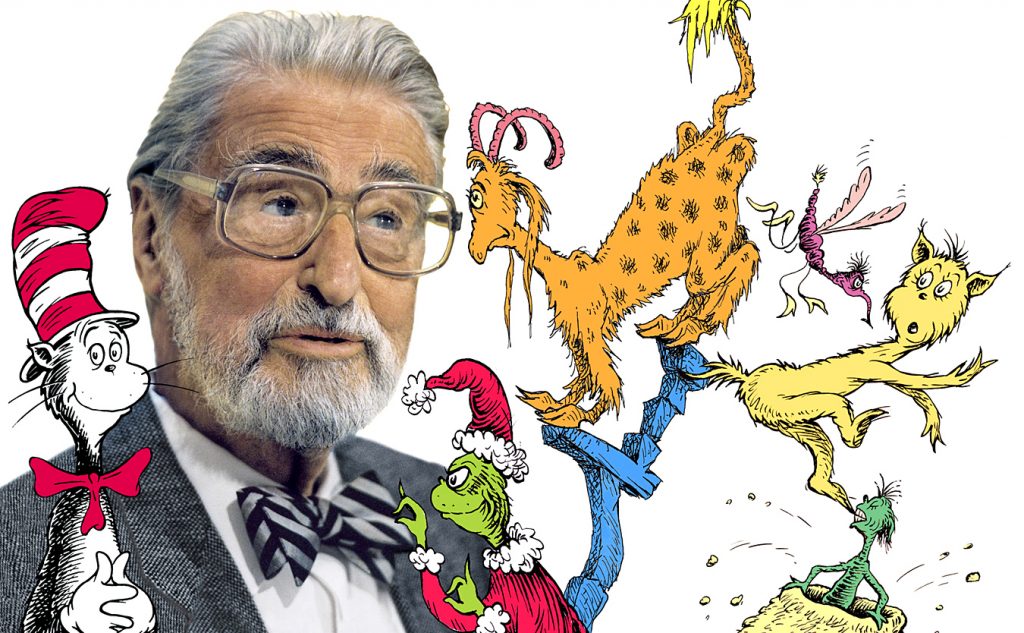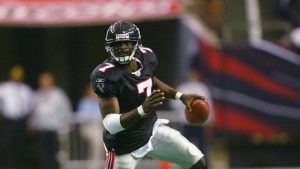Theodor Geisel, beloved children’s author, had a life before he put the hat on the cat. Born March 2, 1904, in Springfield, Massachusetts, Geisel was the only son of German-born immigrants. He spent a normal childhood with his sister and parents, before going to college to become a teacher. Geisel dropped out of college shortly before completing his doctorate in literature. He would eventually turn his almost doctorate and his mother’s maiden name into his now famous pen name, Dr. Seuss.1

In 1927, Geisel decided to turn his passion for drawing and writing into a career in advertising. One of his early successes in advertising was his drawing for Flit insecticide, whose mascot looked very similar to the cat that would eventually wear a striped hat.2 He later created an entire campaign for Essomarine Oil, a division of Standard Oil, called Seuss Navy, in which he designed certificates of membership, pamphlets, and even ashtrays and cocktail glasses that were passed out at trade shows. The Seuss Navy ads ran from 1936 to 1941, and contained many of the sea creatures that would later appear in his books.3 Geisel used many of his made up creatures in various ad campaigns and was the first person to use humor to sell products, altering the advertising industry.4

In 1941, Geisel left advertising to work as a political cartoonist for liberal New York newspaper PM. He drew over 4oo cartoons targeting such topics as isolationism, antisemitism, and racism. He routinely mocked Hitler and Mussolini, but he had a particular flair for attacking American nationalism as well. Believing that the American Nationalist Movement was just another form of fascism, Geisel made Charles Lindbergh a frequent subject of his cartoons.5 After the Japanese attack on Pearl Harbor, Geisel began to use his cartoons to support the war against Japan. He drew cartoons that “depicted Hideki Tojo, the Prime Minister and Supreme Military Leader of Japan, as an ugly stereotype, with squinting eyes and a sneering grin.”6 Geisel was in support of Japanese internment camps and drew several cartoons about them.

It can be hard to imagine that Dr. Seuss could be a racist in his depiction of Asians, but he later admitted that this was exactly the case. At the time, PM did not receive one letter of complaint about Geisel’s stereotypical depiction of Asians, although they received many letters when Geisel mocked the German dachshund, which was popular among American dog owners. Dr. Seuss later said that his 1954 book, “Horton Hears a Who,” written after a trip to Japan and dedicated to a Japanese friend, is meant to be an apology to the Japanese people for his depictions of them during World War II. In the 1980’s, Geisel looked through all his children’s books and removed anything he felt was racist, changing them for any future publication.7
Geisel’s political cartoons ended when he joined the Army in 1943. The now Captain Geisel was assigned to a unit that made training films for the Army, working with the likes of Stan Lee (creator of super heroes) and Chuck Jones (creator of the Road Runner and Wile E. Coyote).8 Geisel and Jones would become life long friends and would work together on various projects, including the animated “How the Grinch Stole Christmas,” which is still shown every year on television.

Geisel’s first children’s book was “And to Think I Saw It on Mulberry Street,” and was published in 1937. However, his writing career almost never happened. The book had been turned down by 27 publishers and Geisel was ready to give up the idea of becoming a children’s author when he ran into an old college friend while walking down the street. His friend had recently become an editor at Vanguard Press and asked Geisel to send him the book so he could show his boss. Geisel would later say in interviews that it was pure luck that he walked down that side of the street that day.9
Dr. Seuss later claimed that he did not like to write books that had a moral or ethical lesson, because children could see a lesson coming and would not want to read the book.10 However, all of Geisel’s books, except his Beginner Books, contained lessons of some sort. Dr. Seuss wrote books with lessons on environmentalism, racial equality, the pointlessness of the arms race, materialism, and respect, just to name a few. He was one of the first children’s authors to write books for children with the respect and care typically reserved for adult literature.11
Dr. Seuss died on September 24, 1991 at his home. He was asked shortly before he passed away to leave a message for children. He wrote “The best slogan I can think of to leave the kids of the U.S.A. would be ‘We can…and we’ve got to…do better than this.’ He then crossed out ‘the kids of.'”12 Dr. Seuss left a legacy of children’s literature that will not soon be forgotten, but he did more than that; Dr. Seuss taught children to think.
- Janet Schulman and Cathy Goldsmith, Your Favorite Seuss (New York: Random House, 2004), 6. ↵
- Louis Menand, “Cat People,” The New Yorker (December 2002). ↵
- Janet Schulman and Cathy Goldsmith, Your Favorite Seuss (New York: Random House, 2004), 55. ↵
- Janet Schulman and Cathy Goldsmith, Your Favorite Seuss (New York: Random House, 2004), 117. ↵
- Sophie Gilbert, “The Complicated Relevance of Dr. Seuss’s Political Cartoons,” The Atlantic (January 2017). ↵
- Sophie Gilbert, “The Complicated Relevance of Dr. Seuss’s Political Cartoons,” The Atlantic (January 2017). ↵
- Sophie Gilbert, “The Complicated Relevance of Dr. Seuss’s Political Cartoons,” The Atlantic (January 2017). ↵
- Janet Schulman and Cathy Goldsmith, Your Favorite Seuss (New York: Random House, 2004), 9. ↵
- Louis Menand, “Cat People,” The New Yorker (December 2002). ↵
- Janet Schulman and Cathy Goldsmith, Your Favorite Seuss (New York: Random House, 2004), 190. ↵
- Janet Schulman and Cathy Goldsmith, Your Favorite Seuss (New York: Random House, 2004), 84. ↵
- Janet Schulman and Cathy Goldsmith, Your Favorite Seuss (New York: Random House, 2004), 190. ↵



125 comments
Trenton Boudreaux
This was a good read about a man I do not often think about. It’s a shame to see that at one point in his life he was racist, but I feel he more than made up for it in his later children’s books. Interesting to see how he was able to put in messages that were usually saved for adult literature and hide them subtly.
Cynthia Perez
Never would’ve thought of Dr. Seuss as a racist. That really is shocking to learn about and more so unexpected. His writing was mostly influential in a way that encouraged equality and positivity, so to see how he had those views at a time in his life is odd. I’m glad he was one that wanted to make up for and eradicate that ignorance by dedicating a book to someone. While correcting his wrong and creating a pathway for literature to uplift children’s spirits rather than spread negativity, Geisel is still considered one of the most amazing authors out there.
Emmanuel Diaz
From reading this I was very surprised to hear about Dr. Suess being a racist as i thought his audience was children all along. I never knew he also advertised for the army and for gas as well. I enjoyed his books when I was little and always enjoyed the bright colors and the creative and different characters in which he had drawn. As a kid i would see many children rushing to get his books and reading them in class. I recently was read one of his books, and yes i was read to by my high school teacher as a ” taking the next step in life” and let me say, hearing the simplicity of the words really did move me. It shows that the words were not only meant for kids but for those who are still in touch with their inner child.
Sofia Martinez
It’s interesting to find that Dr. Seuss dropped out of college and wanted to pursue a doctorate in literature, I had thought that his main inspiration was to write and draw for children’s books. I had not known that he was politically involved as well, the amount of work and time he put into for different things really puts you in the aspect of the passion that he had for his work.
Kristina Tijerina
I was shocked to read about the part that said Dr. Seuss was a racist towards Asians, and that he admitted to it. I never knew he had that perception during World War 2, however I am relieved that he wrote and dedicated “Horton Hears a Who,” to a Japanese friend and used it as an apology after leaving Japan. Dr. Seuss is such a great storyteller, and it baffles me that he might not have become a children’s book author if he had not walked down the particular street that he walked down on that specific day. All his children’s books are a great piece of work with lessons about environmentalism, racial equality, etc. It’s great that he incorporated such lessons while also making the books really fun for children.
John Estrada
I thoroughly enjoyed reading this article. Dr. Suess is one of the most renown artist and writer for people of all ages. He’s an icon of history, a man who all children grow up reading and having fond memories of, including myself. I hold dear the memories of watching The Grinch on VHS, eating green eggs and ham, and celebrating Cat in the Hat day and meeting the cat himself. It’s a very good article topic, in the sense that it’s over something everyone can relate to and be interested in. I loved reading about Suess’s history with advertising, war, and racism. As I’m sure most are interested in reading. Last fact about Suess to end the comment off: Dr. Suess was having an affair while his wife was dying of a disease, ultimately leading her to suicide. Not so perfect after all.
Briana Montes
As a child, I was in love with reading Dr.Seuss. I enjoy that he helps children learn and read in a fun and exciting way. I found it fascinating to learn about his back story, it is something I didn’t know about till now. Its so nice that he is so successful in doing what he does. He is truly inspiring. Great article!
Kelsey Sanchez
I really enjoyed reading this article. It brought back my childhood of reading all of Dr.suess’s books. They were quite interesting due to like this article said making us think and not teaching us a lesson like any other children book would. I’m glad that he didn’t give up on getting his books published because then he wouldn’t have been known today. It’s crazy to know how many people denied his books and just by encountering an old friend, his life changed from there. I’m happy to learn more about his background and how he became the writer of his books. This article was wonderful.
Felipe Macias
Its intense to discover well known people and brands had an impact on global causes like the World Wars. Same with Disney, these artists draw and compile messages for the public for the war effort. This is eye opening and makes you wonder of the hidden and untold stories that are connected to the common household names we hear of everyday.
Charli Delmonico
This was a very interesting article. It is crazy to think that Dr. Seuss’s work was turned down by so many people before he saw an old friend walking down the street who helped him publish his work. it is weird to think that he would struggle at all, given the amount of success he has had writing children’s books. Now, people view him as the epitome of a strong author who knows how to reach and touch his audience unlike any other.